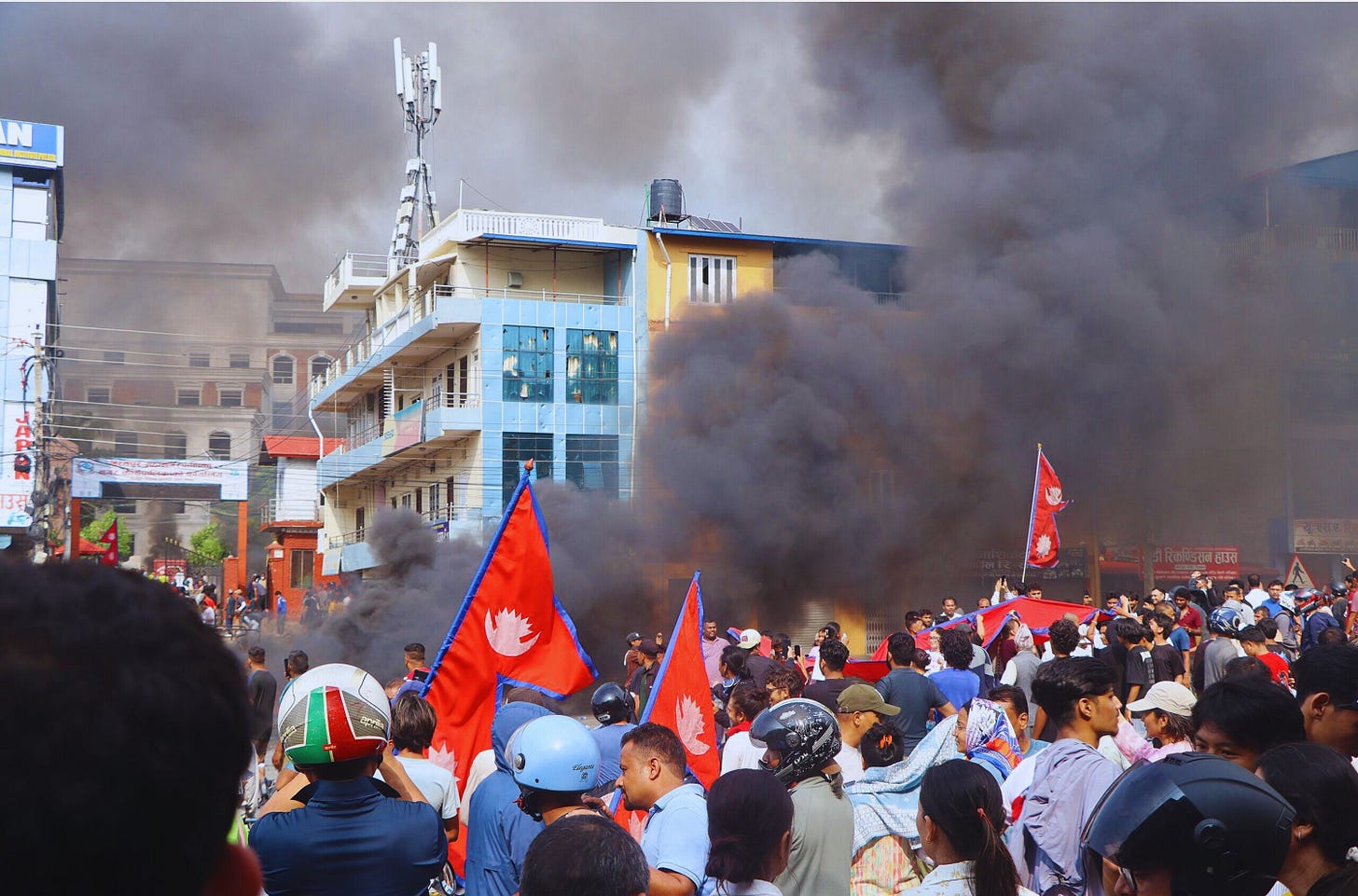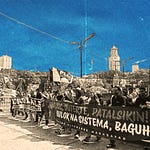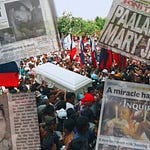It’s a cartoonish yet effective variation of the traditional Jolly Roger: atop a black rectangle, two femurs sit crossed behind a skull that’s sporting a red and yellow straw hat — its comically round eyes and wide grin appear playful, yet manic; slightly crazed, yet focused; almost too cute to be sinister… but not totally innocuous either.
Anyone familiar with the manga-turned-anime, One Piece, would recognise the image as the calling-card for the long-running series’ protagonists, the Straw Hat Pirates: a group of underdogs, misfits and outsiders, fighting against overwhelming odds, often facing off against a overly militarised government force — and through their strength of will, skill, savvy and gumption, frequently prevailing (I’m assuming; I’m not that familiar with One Piece, so correct me if I’m wrong, but 21 anime seasons and 112 manga volumes would suggest that Luffy’s crew is doing okay).
20-something years after its debut, the flag has since become the go-to sigil of youth-led movements that are spreading across Asia. “It has come to kind of represent anger, and frustration, and anti-authoritarianism,” says independent journalist, Pranaya Rana. “It’s become kind of a symbol against the establishment.”
The smiling skull in a straw hat has become a staple at protests in Indonesia, the Philippines, and (arguably most dramatically) in Nepal — where a little over two weeks ago the skull and crossbones image was draped across the gates of the country’s parliament as the government building burned in the background.
By the time the flag was placed there, Nepal’s government had already stood down and fled the capital, after a youth-led revolution — which has been dubbed the Gen Z Protests — forced its collapse.
Talkin’ bout a revolution
The build up to this moment had been unfolding for some time. Anger was already brewing over issues like government corruption, mismanagement, and a growing disconnect between the political establishment and large swathes of the populace. This frustration was exacerbated by a high unemployment rate, hovering just above 10%, while many who found work were stuck in extremely low-paying roles with little-to-no job security.
At the same time, Nepali youths were becoming increasingly angered by the opulent lifestyles touted by the children of politicians — seen as the beneficiaries of extreme nepotism at the nation’s expense. “These children, who are also Gen Z or Millennial, appeared to have untold amounts of wealth,” says Pranaya.
“They lead extremely lavish lives. They take vacations in Europe every few months, they carry designer handbags, and shoes, and clothing; they drive around in cars that the ordinary Nepalis could never afford in their entire lives. So the young people […] compared their lives to the lives of these kids, and they thought ‘how come these people get to live like this when the rest of the country is barely making a living?’”
On September 4, the authorities announced a shutdown of over two dozen social media sites. If they had hoped that clamping down on online discussions would quell the growing dissent, their plan backfired massively. Young people not only found ways to bypass the shutdown, but the move also brought more people to the streets in even greater numbers than before.
A similar movement had recently taken place in Indonesia, where protests had spread over issues like the spiralling cost of living, lack of job opportunities and government excess. But if the spark of these protests was lit by social inequality, then the brutality of the police and security services acted as fuel poured on the fire.
In Indonesia, the demonstrations escalated almost overnight after a police armoured car was videoed running over and killing a young GoJek driver who was passing through a protest to make a food delivery. The video went viral, and ignited a wave of violent clashes between demonstrators and the police across the nation, resulting in several deaths and multiple government buildings burned to the ground.
But the outcomes between Indonesia and Nepal were stark: in the former, the government ostensibly agreed to the political reforms demanded by the protesters; in the latter, the protests quickly grew into a revolution that led to the government’s collapse.
Welcome to the Asia Spring
The events of September 8 are likely to become etched into the psyche of a generation in Nepal, after police opened fire on protesters with live rounds. The aftermath left at least 19 people dead, many of them teenagers or young adults.
“What really shocked me, and most of Nepalis, was the was the violence on September 8 […] where a largely peaceful protest was met with such lethal suppression. We had never seen that happen, especially not in Kathmandu,” says Pranaya.
“There were videos of these shootings of these killings that went viral and ignited anger across the country […] Once again, en mass there were thousands of people on the streets, and initially things were subdued even though there was anger. But quickly they gave way to violence. First against the security forces, the Nepal police, who they thought were responsible for shooting these protestors, and then the violence escalated towards the politicians who had been in power for these last two decades.”
The movement spread rapidly, with young people spearheading what quickly became an uprising to dismantle the political establishment. Politicians were attacked on the streets and their homes were ransacked and burned down, following by the burning of the parliament, the supreme court and the presidential residence.
By September 9, prime minister K. P. Sharma Oli, who had been in power on and off for the past decade, resigned and fled the capital — effectively dissolving the sitting government. Since then, the protests have died down while an interim government has taken over.
‘It could go either way’
Friday September 26 marks the two week anniversary since the formation of Nepal’s current government.
With former Supreme Court justice Sushila Karki serving as prime minister (the first woman to hold the role) many of her cabinet picks are relative unknowns; they’re not the usual cut-of-the-mill political elites that Nepalis have come to know and hate, with Pranaya describing them as ‘bureaucrats’ and ‘technocrats’: “They’re ‘cleaner’ than the previous government, the previous ministers that we had,” he says.
“It’s very early to tell how they’re going to do and how they’re going to handle this interim moment. Because this government isn’t elected, it doesn’t have the electoral mandate that an election provides, they’ve basically been picked and appointed by the prime minister, so they don’t have that much legitimacy among the broader public. But they do have the vibe of the Gen Z protestors. So they are kind of working with that mandate.”
The situation in Nepal remains highly volatile and uncertain. The current death toll from the protests stands at 74, with more than 2,000 people injured. While the interim government has promised elections in March next year, what will happen between now and then is rife with uncertainty, and venerable to interference from bad-faith actors at home and abroad.
“It could go either way,” says Pranaya, describing his feelings as somewhere between ‘optimistically pessimistic’ and ‘pessimistically optimistic’. “This is a sensitive and very scary time for us,” he adds. “But we have to remain vigilant, and we have to remain somewhat optimistic. We have to believe that something can be done and something can change.”
For this, he’s looking to the generation that brought about this change in the first place: “We’ve all tried, right? Gen X tried during the 1990 people’s revolution. Then us Millennials, we tried during 2006/2007, the second People’s Movement. Now it’s the turn of the Gen Z — it’s their revolution.”
Further afield, it’s clear that the youth-led protest movements are spreading. As of the time of publication, demonstration organisers in Indonesia say they are closely watching how the government handles its promised reforms, while similar protests continue to grow in the Philippines. The movement has reached the point where some have dubbed these series of protests as the Asia Spring — a term echoing the Arab Spring, the mass uprisings that swept across the Middle East in 2010-2012.
In this episode
For this episode of the Currents podcast, I speak with Pranaya about the situation in Nepal — what led up to this moment, and where it might lead from here.
It’s not often one is able to hear from someone with a front-row seat to an ongoing revolution. While above article is an admittedly brief summation of (some of) the protest’s major developments, for a more detailed and nuanced understanding I urge you to listen to the entire interview — where Pranaya discusses his hopes and fears following the uprising that toppled Nepal’s government.
If you want to learn more about this topic and receive updates about the situation in Nepal as it develops, check out Pranaya’s newsletter, Kalam Weekly. And for more background on the protests in Indonesia, you can listen to my interview with Andreas Harsono, an Indonesia researcher for Human Rights Watch.
Happy sailing!













